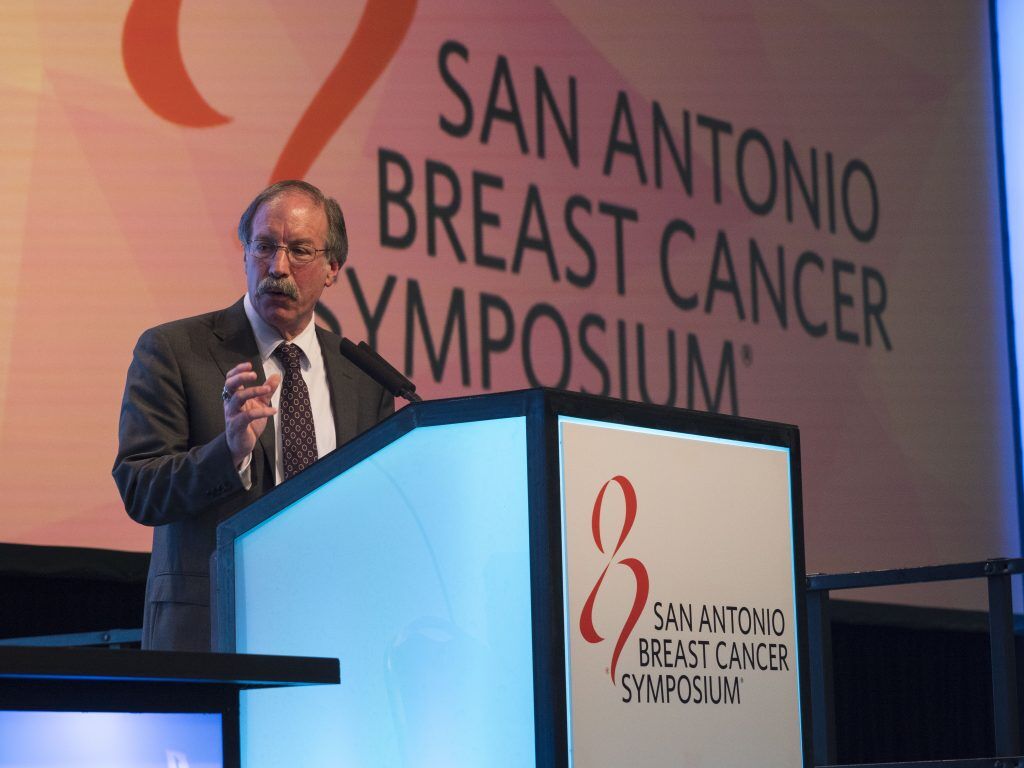Presentations from BCRF grantees highlight treatment options and prevention strategies
The last full day of SABCS 2015 started with a discussion on the past and future directions of HER2- directed therapies. In his lecture, Dr. Mothaffar Rimawi of Baylor College of Medicine described the advancements in treatment of HER2-positive breast cancer starting with the development traztuzumab (Heceptin ®), the first targeted therapy for this disease. Traztuzumab and other HER2-targeted therapies that have followed (pertuzumab, TDM-1, lapatinib, afatinib and neratinib) helped to transform a disease with poor prognosis into a treatable and survivable type of breast cancer.
Despite the remarkable improvement traztuzumab offered in HER2-positive breast cancer, many of these tumors were resistant to the therapy, leading to clinical trials testing combinations of HER2-targeted therapies with chemotherapies in both the pre-surgery (neoadjuvant) and post-surgery (adjuvant) settings.
Results from these trials consistently show that in spite of improved outcomes, not all patients do well with the combination therapies –due either to drug resistance or side effects. This observation opens the door for alternative strategies such as de-escalation of therapy – omitting certain treatments or replacing them with less toxic agents without compromising outcome.
Dr. Rimawi pointed to other examples where reducing treatment had equal or better benefit when compared to the standard therapy: 1) breast conserving surgery (lumpectomy) versus mastectomy; 2) omitting radiation in selected breast cancers, and 3) omitting chemotherapy in low-risk ER-positive breast cancers, as was recently shown in a report from the TAILORx study.
Clinical trials omitting or reducing chemotherapy in HER2-positive breast cancer have shown some benefit, particularly in HER2-positive/ ER-negative breast cancers. Subsequent studies suggested that activation of ER in response to HER2 therapy may be a driver of resistance, and that adding anti-estrogen therapies may improve outcomes in some HER2-postive breast cancers.
Overall, studies to date demonstrate that HER2-positive breast cancer is a heterogeneous disease and the need for biomarkers to identify the appropriate course of treatment for each patient.
Other highlights from Friday’s presentations:
Activation of gene networks associated with response to traztuzumab and lapatinib
The neoALTTO trial was a randomized phase II trial to test the effect of dual HER2-targeted therapies in combination with chemotherapy in the pre-surgical (neoadjuvant) setting. Results from this study reported at SABCS in 2010 and 2013 showed a significant improvement with the dual HER2 therapy versus HER2 monotherapy with chemotherapy both in pathological complete response (pCR–the absence of residual tumor) after six weeks of treatment and improved disease free survival with four years of follow up, respectively.
BCRF investigator Dr. Lajos Pusztai reported follow up analyses that examined whether mutations to individual genes or the overall mutational load (extent of gene mutations) could predict patient response to HER2-therapies. The study team identified 33 genes associated with response to the HER2-targeted therapies, but different genes were affected in different patients. Instead of single genes driving response to the therapies, their results showed that mutations in gene networks (collections of genes involved in a particular process) were better predictors of response.
Dr. Pusztai’s study demonstrates that mutations in gene networks, rather than individual genes, may be important in defining patients most likely to respond to treatment regimens, in this case traztuzumab and lapatinib, alone or in combination.
These findings are significant in that they may help to identify patients most likely to benefit from the dual HER2-targeted therapies. This is important in light of the fact that in the ALTTO trial, in which patients received a similar therapy after surgery (called adjuvant therapy), those patients receiving both traztuzumab and lapatinib did not do better than those receiving traztuzumab alone.
Preventing recurrence in DCIS
Studies have shown that aromatase inhibitors (AIs) are more effective than tamoxifen in hormone receptor (HR) positive, invasive breast cancer in postmenopausal women. However, little is known on the benefit of AIs in ductal carcinoma in situ (DCIS). Two studies presented during Friday’s session showed that the commonly prescribed AI, anastrozole, was equally effective if not better than tamoxifen in prevention of recurrence in patients with DCIS. Both studies highlighted differences in side effects, most of which were expected based on the toxicity profiles of the two drugs.
BCRF investigator, Dr. Jack Cuzick reported data from the IBIS- II DCIS trial conducted in collaboration with BCRF colleague John Forbes, in which the AI anastrozole was compared to tamoxifen in women with hormone receptor (HR) positive DCIS. The international study randomized a total of 2980 women from 238 clinical research centers in 17 countries to receive either anastrozole or tamoxifen. After a minimum of five years of follow up and recurrence data out to ten years, the study investigators found little difference in recurrence, though there was some suggestion that anastrozole performed better in preventing recurrence. Dr. Cuzick noted the previously unreported side effect of increased cardiovascular events with anastrozole.
BCRF investigator Dr.Patricia Ganz reported on patient-reported outcomes from the NRG Oncology/NSABP – B35 phase II trial, which showed a significant improvement in cancer-free interval with anastrozole compared to tamoxifen following lumpectomy for DCIS. Dr. Ganz’s quality of life and symptom analysis did not find any significant differences between the two treatments, but as noted in the IBIS-II DCIS study, there were differences in side effects with two agents.
“This information, for both patients and doctors, will enhance the management of side effects to keep people on therapy – that is the goal,” Ganz said. Read more about the study here.
Collectively, these studies show that anastrozole is another option in the treatment of DCIS. Consideration of side effect profiles will be important in guiding decision-making and patient preferences. Both studies (IBIS-II DCIS; NSABP B-35) were published in the Lancet.







